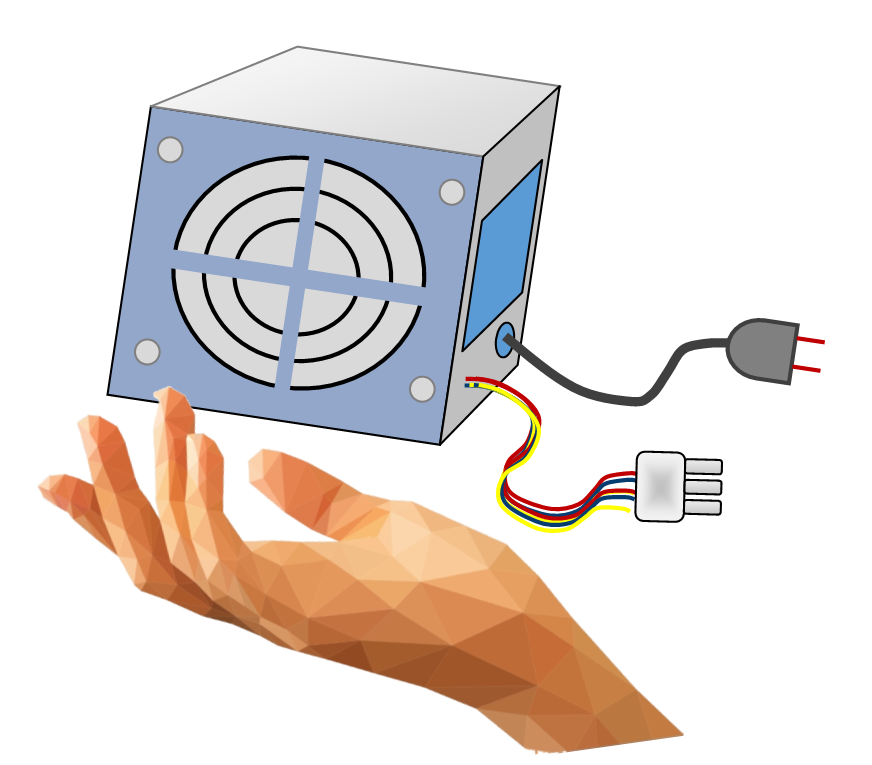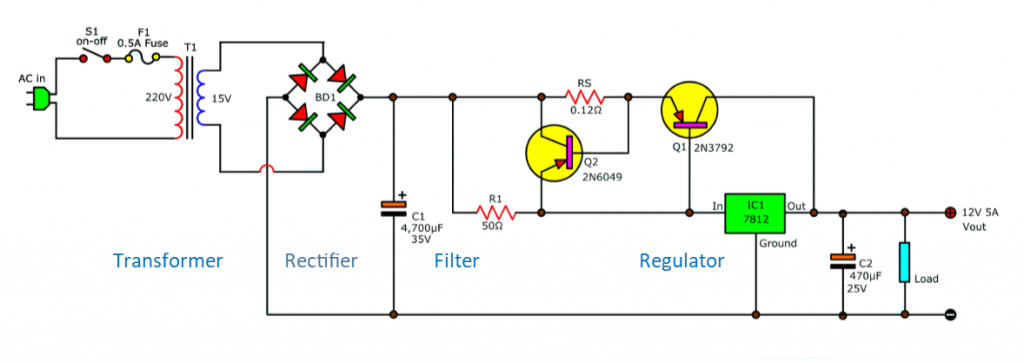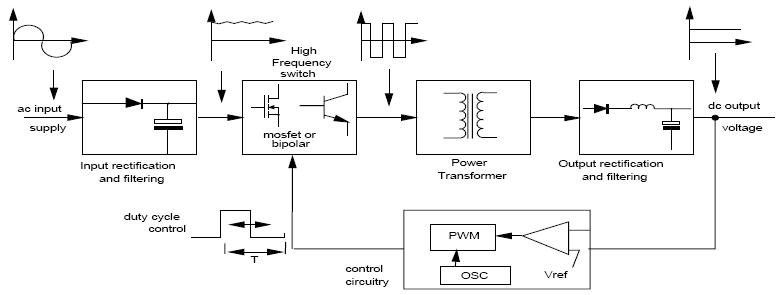Access Control, IP Cameras, and Intercoms Need Power Supplies
Designing a power supply is one of the first electrical engineering tasks I did in college. I remember those days. We learned many things, such as don’t drink a lot of beer before the lab class. Don’t put your finger in the electric socket. Always try to guess what’s on the test. And, stay away from courses about antennas because they were terrifying.
Power supplies are in computers, IP cameras, access control systems, IP paging, and intercoms. It is one of the most underrated components of a computer system. When you specify a computer, you think about the processor speed, the memory, storage, and display card. The power supply is never considered. Of course, if it fails, none of the other components will work. Sometimes it’s the most unsophisticated part of the system that is the most important. Does anyone remember the old joke about the argument between the various parts of the body*?

This article describes how a power supply works and some things you should consider when purchasing a power supply.
What is a Power Supply?
The Power Supply Unit (PSU) is a device that transforms energy from the electrical power input into power that can be used by a computer-type device. The computer type Power Supply converts the power from AC (Alternating Current) to DC (Direct Current) power, provides a fixed output voltage level, and regulates or maintains the output voltage over a range of load conditions. It doesn’t actually “supply” power; it converts or changes it so an electronic device can use it.
For example, your computer’s power supply converts 120 VAC alternating current (AC) into low voltage direct current (DC) power at 5 VDC or 12 VDC. The PSU (Power Supply Unit) also has to regulate the voltage output to ensure it doesn’t vary by more than a few percent. It also usually includes a current limiting switch that shuts off (like a fuse) when too much load current is detected. This protects the load device from damage.
Power Supply Concept Diagram
The power supply consists of four major parts.
- Transformer: Adjusts the AC voltage to the right level for the specific power supply
- Rectifier: Converts the AC signal (Alternating Current), so that is always positive (DC)
- Filter: smooths out the bumps in the signal
- Regulator: adjusts the output DC voltage so that it maintains the right level (12 VDC). It maintains a constant voltage despite the change in the load.

Types of Power Supplies
There are two types of power supplies, the linear power supply, and the switching power supply. The linear power supply has a simple design and is less expensive than the switching power supply. The switching power supply is more complicated but is much more efficient and flexible.
Linear Power Supply
Here is an example of a circuit diagram. The linear power supply includes a large transformer that adjusts the input voltage, a rectifier, transistors, and a voltage regulator component.

Advantages of Linear Supplies
- Simple Device. Linear regulators use fewer components than the switching supplies. The circuit diagram above shows how a regulator chip (7812) can be used in a power supply.
- Low cost. If your device requires a power output of less than 10W, then the component and manufacturing costs are much lower than switching power supplies.
- Low noise/ripple. Linear regulators have a very low output voltage ripple and high bandwidth. This makes them ideal for any noise-sensitive applications, including communication and radio devices.
Disadvantages
- Larger: Linear power supplies require a larger transformer, so they are larger and heavier than the switching power supplies.
- Limited flexibility. Linear regulators usually can be used with a fixed input voltage and frequency. For example, they are designed to be connected to 120 VAC 60Hz or 240 VAC power input. If you want to use 240 VAC power, you need to switch taps on the input transformer.
- Limited outputs. Linear regulated power supplies only provide one output voltage. If you need more, you’ll need to add a separate linear voltage regulator per required output.
- Poor efficiency. The average linear regulated device achieves an efficiency between 30%-60% due to heat dissipation. It also requires a heat sink, which adds to the device’s size and weight.
Switching Power Supply
Many of today’s power supplies use switched-mode power. This type of power supply incorporates a switching regulator to control the voltage and current. It is more flexible and much more efficient than the linear power supply. They are used in intercoms, IP cameras, access control reader-controllers.
The diagram consists of many more blocks than the linear supply.

The switch-mode power supply can handle many different levels of AC (Alternating Current) input voltage and frequency. Computer products are sold in Japan, where the power is 100 VAC 50 Hz, and in France, where the power is 230 Volts at 50 Hz. The switching power supply can accommodate all these power sources.
Switching supplies can also convert DC power from one voltage level to another. For example, PoE injectors provide around 48 Volts DC to a device on the network. The IP device, such as a camera, has a DC to DC converter that converts the 48 VDC to 5 VDC to power the camera circuits.
Advantages & Disadvantages of Switching Supplies
Switching power supplies might have a higher efficiency than linear regulators, but they could be a problem in some situations where noise makes them a poor choice. For example, radio and communication applications require low-noise power.
Advantages
- Small form factor. The step-down transformer in the switching-regulator operates at a high frequency, which means the transformer is much smaller and lighter.
- High efficiency. Voltage regulation in a switching power supply dissipates less heat. The efficiency can be as high as 85%-90%.
- Flexible applications. Additional windings can be added to a switching power supply to provide more than one output voltage. A transformer-isolated device can also provide output voltages that are independent of input voltages.
Disadvantages
- Complicated design. The design requires more components, and so it should be designed carefully to maintain reliability.
- High-frequency noise. The switching operation of the MOSFET within a switching power supply provides high-frequency noise in the output voltage. This often requires the use of RF shielding and EMI filters in noise-sensitive devices.
- Higher cost. For lower power outputs of 10W or less, it’s cheaper to use a linear regulated power supply.
Summary of Power Supply Selection
The power supply converts voltage levels. It also transforms the power from AC to DC and keeps the voltage constant despite the load. The linear supply costs less but is less efficient and flexible. The switching supply is lighter, costs more, and is more efficient.
*The Joke:
One day the different parts of the body were having an argument to see which should be in charge.
The brain said, “I do all the thinking, so I’m the most important, and I should be in charge.”
The eyes said, “I see everything and let the rest of you know where we are, so I’m the most important, and I should be in charge.”
The hands said, “Without me, we wouldn’t be able to pick anything up or move anything. So I’m the most important, and I should be in charge.”
The stomach said, “I turn the food we eat into energy for the rest of you. Without me, we’d starve. So I’m the most important, and I should be in charge.”
The legs said, “Without me, we wouldn’t be able to move anywhere. So I’m the most important, and I should be in charge.”
Then the rectum said, “I think I should be in charge.”
All the rest of the parts said, “You?!? You don’t do anything! You’re not important! You can’t be in charge.”
So the rectum closed up.
After a few days, the legs were all wobbly, the stomach was all queasy, the hands were all shaky, the eyes were all watery, and the brain was all cloudy. They all agreed that they couldn’t take any more of this and decided to put the rectum in charge.
The moral of the story?
You don’t have to be the most important to be in charge; any asshole can do it.
If you need help selecting the IP camera, access control, or IP paging and intercom, please contact us at 800-431-1658 in the USA, 914-944-3425 everywhere else, or use our contact form.